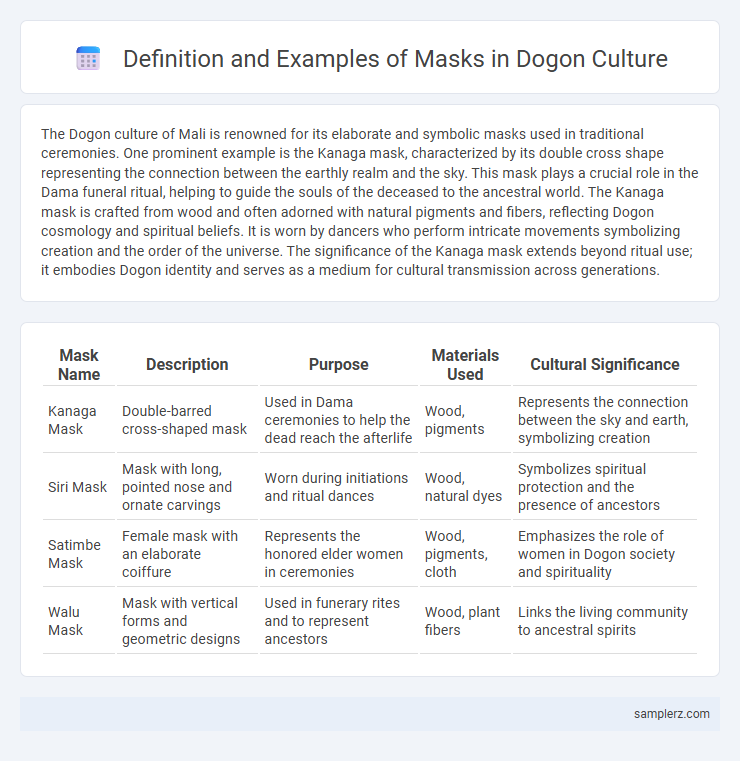The Dogon culture of Mali is renowned for its elaborate and symbolic masks used in traditional ceremonies. One prominent example is the Kanaga mask, characterized by its double cross shape representing the connection between the earthly realm and the sky. This mask plays a crucial role in the Dama funeral ritual, helping to guide the souls of the deceased to the ancestral world. The Kanaga mask is crafted from wood and often adorned with natural pigments and fibers, reflecting Dogon cosmology and spiritual beliefs. It is worn by dancers who perform intricate movements symbolizing creation and the order of the universe. The significance of the Kanaga mask extends beyond ritual use; it embodies Dogon identity and serves as a medium for cultural transmission across generations.
Table of Comparison
| Mask Name | Description | Purpose | Materials Used | Cultural Significance |
|---|---|---|---|---|
| Kanaga Mask | Double-barred cross-shaped mask | Used in Dama ceremonies to help the dead reach the afterlife | Wood, pigments | Represents the connection between the sky and earth, symbolizing creation |
| Siri Mask | Mask with long, pointed nose and ornate carvings | Worn during initiations and ritual dances | Wood, natural dyes | Symbolizes spiritual protection and the presence of ancestors |
| Satimbe Mask | Female mask with an elaborate coiffure | Represents the honored elder women in ceremonies | Wood, pigments, cloth | Emphasizes the role of women in Dogon society and spirituality |
| Walu Mask | Mask with vertical forms and geometric designs | Used in funerary rites and to represent ancestors | Wood, plant fibers | Links the living community to ancestral spirits |
Overview of Mask Traditions in Dogon Culture
Dogon masks, integral to the Dogon culture of Mali, serve as powerful symbols in religious ceremonies and ancestral worship. Each mask design, from the Kanaga with its double cross shape to the Satimbe representing female ancestors, encapsulates unique spiritual meanings and social functions. These masks facilitate communication with the spirit world, marking important rites of passage and community cohesion.
Significance of Masks in Dogon Rituals
Masks in Dogon culture serve as powerful spiritual symbols used during elaborate rituals to communicate with ancestral spirits and ensure cosmic harmony. Each mask, intricately crafted with distinct shapes and patterns, represents specific mythological characters or forces, playing a central role in ceremonies like the Dama funeral rites. These masks facilitate the transition of souls to the afterlife while reinforcing social cohesion and cultural identity within the Dogon community.
Types of Masks Used by the Dogon People
The Dogon people of Mali utilize various traditional masks, including the Kanaga mask, characterized by its double-barred cross shape symbolizing the connection between the earth and the sky. The Sirige mask, tall and vertically elongated, represents the ancestral tree and plays a central role in Dama funeral ceremonies. Additionally, the Satimbe mask, worn by elder women during rituals, signifies female wisdom and the community's spiritual harmony.
Kanaga Mask: Symbolism and Usage
The Kanaga mask in Dogon culture symbolizes the connection between the earth and the sky, representing the cosmic order and the creator's spirit. It is prominently used during Dama ceremonies, which are ritualistic funerals aimed at guiding the souls of the deceased to the afterlife. This mask's unique cross-shaped design embodies the Dogon's cosmology and is central to their spiritual and cultural identity.
Sirige Mask: Meaning and Cultural Context
The Sirige mask in Dogon culture represents the ancestral spirit and is central to Dama ceremonies, symbolizing the cycle of life and death. Characterized by its tall, rectangular form adorned with intricate geometric patterns, the mask embodies the Dogon cosmology and agricultural fertility. Ritual use of the Sirige mask facilitates communication with ancestors, ensuring social cohesion and spiritual continuity within the Dogon community.
Walu Mask: Representation and Purpose
The Walu Mask in Dogon culture symbolizes female fertility and the spiritual connection between the living and ancestral worlds. Crafted with intricate geometric patterns and vibrant colors, it is used during Dama ceremonies to honor the deceased and ensure their peaceful transition. This mask embodies the Dogon community's reverence for balance, renewal, and cosmic harmony.
Satimbe Mask: The Role of Women in Dogon Masquerades
The Satimbe mask in Dogon culture symbolizes the revered role of women as spiritual protectors during masquerades, embodying ancestors who guide and safeguard the community. Characterized by its intricate design featuring elevated coiffures and scarification patterns, the Satimbe mask highlights feminine beauty and strength in Dogon ritual performances. This mask serves as a vital cultural emblem, emphasizing women's influence in maintaining harmony and connection between the living and ancestral spirits.
Materials and Techniques in Dogon Mask-Making
Dogon masks are traditionally crafted using carefully selected wood, often derived from iroko or shea trees, known for their durability and symbolic significance. Artisans employ intricate carving techniques combined with natural pigments sourced from clay, charcoal, and plant extracts to create vivid, meaningful designs. The masks' construction balances spiritual symbolism with functional craftsmanship, reflecting the Dogon people's deep connection to ancestral rituals and cultural identity.
Dogon Mask Dances: Performance and Interpretation
Dogon Mask Dances hold profound cultural significance, featuring intricately carved wooden masks representing ancestral spirits and mythological figures central to Dogon cosmology. These performances, typically seen during ceremonies like the Dama funeral ritual, serve to guide souls to the afterlife and reinforce communal identity through symbolic movements and rhythms. The masks embody a visual language that conveys complex narratives about creation, social order, and spiritual protection within Dogon society.
Preservation of Traditional Mask Practices in Modern Dogon Society
Dogon culture in Mali preserves traditional mask practices through annual ceremonies like the Dama, where intricate wooden masks embody ancestral spirits and facilitate transitions between life stages. These masks, carved with symbolic motifs unique to Dogon cosmology, maintain cultural identity despite contemporary influences. Community-led workshops and storytelling sessions sustain mask-making skills, ensuring that artistry and ritual significance endure in modern Dogon society.

example of mask in Dogon culture Infographic
 samplerz.com
samplerz.com